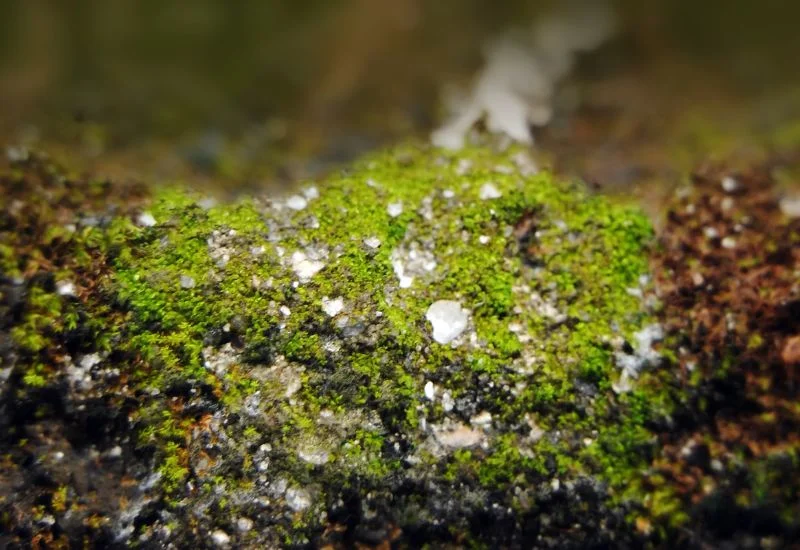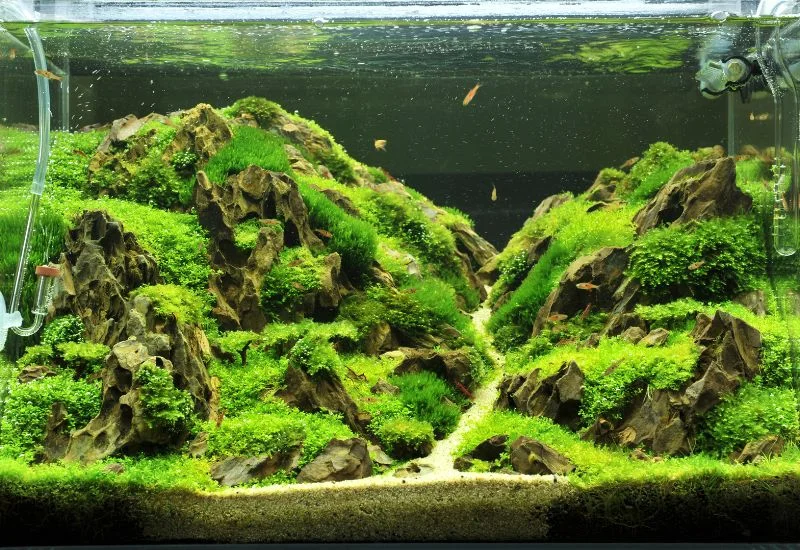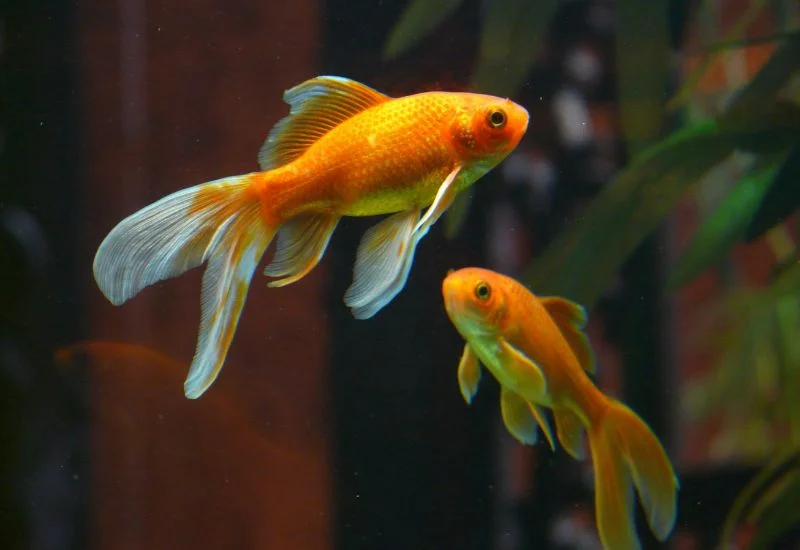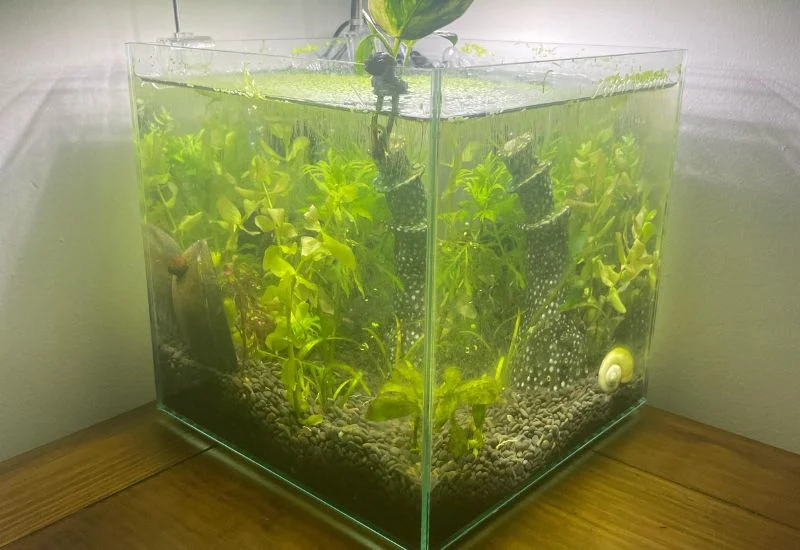Algae are water plants that find good conditions to grow in the aquarium. Lacking knowledge about what causes algae growth can negatively affect a tank’s environment.
More exposure to sunlight, overfeeding the fish, poor water quality, and turning the aquarium’s light on most of the time can cause the rapid growth of algae.
Here are some guidelines on how you can control algae growth.
Understanding Algae Growth
There are multiple factors which can cause the growth of algae:
- If the tank is receiving too much light from the sun, that can cause the growth of algae
- Overfeeding fish can lead to uneaten food in the tank, which can cause algae growth
- Leaving the aquarium’s light on for more than needed time can promote the growth of algae
- Not changing the aquarium water at regular times can cause the growth of algae
- Excessive nutrients, such as phosphate, can promote algae growth
Types of Algae

Before treating the algae, it is important to know what type of algae it is. Here are the types:
Brown Algae
This algae appears on the aquarium substrate. It is called grovel algae. There is no harm of this type. Brown algae can appear in a new tank and will disappear with time.
Blue-Green Algae
This algae is produced by high nutrient levels in the water, such as phosphate. It’s hard to control the growth once it begins. This type of algae is also known as slime or smear algae, and is scientifically referred to as cyanobacteria.
Red Algae
This type of algae is the most difficult to eradicate. This normally grows on the plants. We can reduce the algae growth by dipping plants into a bleach solution of 5% to 10%, which can kill the algae.
Green Algae
Every aquarist will encounter this type of algae. This algae is also known as hair or spot algae. It grows in every tank at some point. If you control the environment of the tank, there will be no overgrowth of the algae. This can be reduced by adding algae-eating fish to your tank.
Advantages of Algae
Having some algae in the tank can be good for fish. Here are some points:
- Having some algae will increase the aesthetic of your aquarium as it gives a natural look to the tank.
- Algae are a good snack for some fish and invertebrates.
- It is the best source of vitamin A, and consuming algae can keep fish healthy and enhance their coloration.
- Some types of algae are the best filter for the tank. Algae consume the nitrates and nitrites from the water and keep the tank clean.
How to Control Algae Growth

Regular Water Changes
- Change 15% to 20% of the water every week. This reduces the amount of nutrients like phosphate and nitrite, which promotes the growth of algae
- Clean the water filter at regular times to ensure clean water quality. Low water quality provides grounds for the growth of algae
- Place live plants into the aquarium. Plants eat the organic from the water, which reduces the number of nutrients in the tank
- Adding algae-eating fish like Siamese Algae Eater can reduce the amount of algae in the water
- You can use different algae control treatments available in the market that can control and kill the algae
Proper Lighting Control
Here is the guide on how you can use the light for the prevention of algae
- Tanks without plants need 8 to 9 hours of light per day, and the aquarium with plants needs 10 to 12 hours of light
- Set the timer to control the light
- Light quality can promote the growth of algae. Try to change the aquarium bulbs every 8 to 10 months
- Too much light intensity can cause algae growth. You can dim the lights or use black tape to reduce the intensity of the light.
- Direct sunlight can cause algae growth. Try to place your tank where there is no direct sunlight
Controlling Nutrient Levels
Here are some nutrient-controlling factors that can reduce the growth of algae:
- Feed your fish a proper nutrient control diet rather than overfeeding
- Overfeeding will cause an excess amount of nutrients in the water
- Place live plants in the water. The plants consume the same nutrients as algae dose
- If you are placing plants just to stop the algae growth, you can use stem plants
Algae Eating Fish
Here is the list of algae-eating fish that can reduce the growth of algae in the tank:
Siamese Algae Eater
This fish is 6 inches long and stays at a temperature of 24° C to 26°C. The fish can easily live in medium to large tanks. This hungry little fish will happily nibble away the growing algae on the rocks but also clear the uneaten food from the bottom of the tank. This fish is a good neighbor. The only thing you need to watch is their tendency to jump.
Bristlenose Plecostomus (Bristlenose plecos)
This fish size is 5 inches and stays in temperatures 23° C to 27° C. The medium tank is perfect for a fish stay. This is famous for chopping their way through algae and having a huge appetite. Bristlenose likes to stay on the bottom of the tank near hiding places like caves and driftwood.
Otocinclus Catfish (Otos)
The fish size is 1 to 2 inches, and the ideal temperature to live is 22° C to 26° C. The fish can stay in small, medium, or in large tanks. The fish is small in size and can eat algae from the corners of the aquarium. Even if the fish is small, they have a good appetite. If there is minimal growth of algae, try to give some courgette to the fish.
Chinese Algae Eater
The fish size is 10 inches and stays in temperature from 24° C to 27° C. The fish can stay in the aquarium from medium to large. This algae-eating fish is the best to keep with aggressive fish. The fish is semi-aggressive towards the same size and color of fish. To maintain harmony in the tank, the fish needs a space to swim freely. The fish have a huge appetite, and if they don’t get proper food, they attack large fish to eat their slime coat. They can injure the fish and leave wounds open for infection.
Nerite Snail
The size of this snail is 3 cm, and the ideal temperature to stay is 23° C to 28° C. The snail can live in medium and large tanks. Nerite algae snails are the favorite of aquarists. The stripe pattern of the snail makes it look great and a perfect addition to your tank. These snails can eat any type of algae happily and keep the tank clean.
Apple Snail / Golden Mystery Snail
The size of the snail is 10 cm and stays at a temperature from 20° C to 20° C. The apple snail can stay in medium to large tanks. The apple snail is also known as Golden Inca Snail and Yellow Snail. They are friendly and live with non-aggressive tank mates. The snails have a good appetite. If there is not enough algae available, give them the needed supplements to maintain the diet.
Red Cherry Shrimp
The size of red cherry shrimp is 1 to 2 inches. They live in temperatures from 22° C to 26° C. They can live perfectly in small to large tanks. The beautiful color of the shrimp will not only add to the aesthetic of your tank but also maintain the algae growth in the aquarium. The shrimp can also eat shrimp pellets, sinking pellets, and algae wafers to complete their appetite.
Amano Shrimp
The size of the amano shrimp is 2 inches and can live in the temperature from 22° C to 26° C. The shrimp can live in tanks ranging from small to large. They are friendly algae eaters who like to stay in a group of six or more. They shed their shells once a month and go into hiding. When feeding time comes, they are more hurried and excitable.
Whiptail Catfish
The size of the whiptail catfish is 6 inches. The fish can stay in the temperature from 22° C to 26° C. The fish can live in large tanks. Whiptail is perfect for keeping in large tanks to stop algae growth. The fish is the best mate to keep with non-aggressive fish. Apart from algae, the fish needs other food like sinking pellets, blanched vegetables, and bogwood. The fish are bottom dwellers and like to spend most of their time on sand substrates.
Twig Catfish
The size of the fish is from 3 to 6 inches. Twig catfish can live in temperatures from 22° C to 26° C. This fish can live easily in large tanks. This algae-eating fish is not recommended for beginners to adopt. The fish is shy in nature and likes to live in groups. The fish are not suitable for keeping large fish as they become stressed easily when confronted.
Manual Removal of Algae

Here are the tips through which you can remove the algae
- One method is to use an algae scraper to remove and wipe out the algae.
- The sponge was made with non-toxic millennia, and it would not damage the glass or acrylic tanks
- If the algae is hard to remove, you can use the Mag-Float Glass Cleaner with matching scraper blades. The blades will easily cut off the algae without damaging the glass
- The other and easy way is the use of a toothbrush. The bristles of the brush will remove the algae from places like the aquarium’s landscape. Decoration and even from the leaves
Preventive Measures For Algae Control
Here are some guides on how you can prevent the growth of algae
- Keep your tank away from the windows where there are direct rays of sunlight. Keep your curtains thick to block the direct effect of light
- Do not leave the aquarium lights on for more than 8 to 10 hours
- Make sure you are given the right amount of food for your fish; uneaten food will provide grounds for the growth of algae
- Change the 10% to 15% of aquarium water on a weekly basis to maintain the level of nutrients
- Check the water quality of your tank. The pH level is the amount of nutrients that can cause the growth of algae
Consistent Tank Maintenance
- Regular water change
- Check the filters in a timely manner
- Provide quality food
- Check the parameters of the water
- Monitor the tank for uneaten food
- Feed less
- Reduce the intensity of light
When to Seek Professional Help

Here are the signs when you should seek professional help
- Seek professional help when the growth of algae is not controlled despite standard treatment
- Treatment like the adjustment of light, water changing routine, feeding habits
- The unbalanced growth of algae makes your tank water cloudy and puts fish under pressure
Conclusion
Algae is a common plant that can be easily found in the aquariums. The limited growth of algae is not harmful, but unbalanced growth can cause several problems. The excess amount of algae can increase the nutrient levels in the water, damage the water quality, cloud the water, and stress your fish. To prevent algae, you should know the types of algae and the reason behind the growth. Too much food, direct exposure to sunlight, no placement of plants, and not changing the water at needed times can cause the growth of algae.
The algae can be eliminated by the placement of plants in the tank, no direct exposure to sunlight, managing the eating habits of the fish, checking the water parameters of the water, and many more. By following these steps, the growth of algae in the aquarium can be managed. When you try every standard treatment, and there is still unbalanced growth of algae in the aquarium, it’s time to seek professional help.
